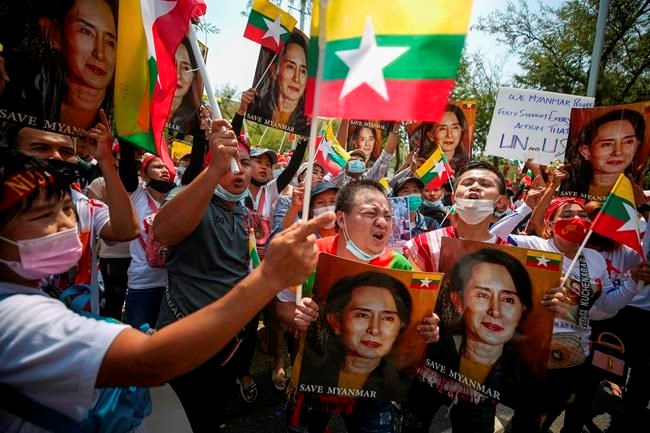YANGON, Myanmar — Myanmar careened deeper into crisis, as police occupied hospitals and universities and reportedly arrested hundreds of people involved in protesting last month’s military seizure of power, while a coalition of
Tension was high Sunday in the country’s biggest city, Yangon, where for a second night running gunshots from heavy weapons rang out randomly in the streets of several
The purpose for security forces using such weapons when protesters had left the streets appeared to be part of a strategy to strike fear in anyone who might think about defying the authorities. In a similar vein, there were many filmed incidents of police and soldiers in plain view savagely beating protesters they had taken into custody.
Some of the shooting was heard near hospitals, where reports said
Security forces have often targeted medical personnel and facilities, attacking ambulances and their crews. Members of the medical profession launched the Civil Disobedience Movement, which is the nominal
Large protests have occurred daily across many cities and towns in Myanmar, and security forces have responded with ever greater use of lethal force and mass arrests. At least 18 protesters were shot and killed on Feb. 28 and 38 on Wednesday, according to the U.N. Human Rights Office. More than 1,500 have been arrested, the independent Assistance Association for Political Prisoners said.
Protests in various cities and towns were again met Sunday by police firing warning shots, and employing tear gas, rubber bullets and stun grenades.
In a single Yangon
Myanmar
“To continue the economic and business activities as usual, and to delay a general work-stoppage, will only benefit the military as they repress the energy of the Myanmar people,” said the appeal, issued Sunday night.
The statement called for the strike to continue “until we receive our democracy back.”
Workers in several industries have joined the protest movement, most notably from the state railway and the banking sector.
Factory workers, mostly in the Yangon area, are largely involved in the garment industry, which generates major export earnings for Myanmar. The workers have participated occasionally in the campaign against the junta, but are unable to do so on a daily basis for fear of losing their modest incomes.
Advocates of sanctions against the junta have purposely avoided calling for comprehensive trade sanctions for fear they would hurt the general populace. Instead they have called for, and enacted, targeted sanctions aimed at hurting the military’s leadership and military-linked companies.
Earlier Sunday, police in Myanmar’s ancient former capital, Bagan, opened fire on demonstrators protesting the Feb. 1 coup, wounding several people, according to witness accounts and videos on social media.
At least five people were reported hurt as police sought to break up the Bagan protest, and photos showed one young man with bloody wounds on his chin and neck, believed to have been caused by a rubber bullet. Bullet casings collected at the scene indicated that live rounds were also fired.
The city, located in the central Mandalay region, is a UNESCO World Heritage Site in recognition of the more than 2,000 pagodas or their remnants situated there, dating from the ninth to 13th centuries, when it was the capital of a kingdom that later became known as Burma and is now Myanmar.
Bagan is best known for being one of the country’s top tourist attractions, but it has also been the scene of large protest marches against the junta.
Multiple reports from Yangon said there had been police raids Saturday night seeking to seize organizers and supporters of the protest movement. A ward chairman from Aung San Suu Kyi’s National League for Democracy party, which was ousted from power in the coup, was found dead in a military hospital Sunday morning by fellow residents of his Pabedan
Suspicion was rampant on social media that Khin Maung Latt, 58, died due to a beating in custody after being taken from his residence, but no official cause of death was immediately announced.
In Yangon and elsewhere, raids are carried out nightly after the 8 p.m. curfew by police and soldiers. The arrests are often carried out at gunpoint, without warrants.
The escalation of violence has put pressure on the global community to act to restrain the junta. The coup reversed years of slow progress toward democracy in Myanmar, which for five decades had languished under strict military rule that led to international isolation and sanctions.
Suu Kyi’s party led a return to civilian rule with a landslide election victory in 2015, and with an even greater margin of votes last year. It would have been installed for a second five-year term last month, but instead Suu Kyi and President Win Myint and other members of the government were placed in military detention.
The Associated Press



